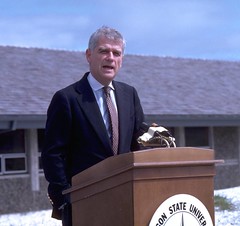NEWPORT – Oregon Sea Grant and the OSU Hatfield Marine Science Center join the Lincoln County School District and the Oregon Coast Aquarium this Tuesday to host Lincoln County’s first K-12 Ocean Literacy Symposium.
Sessions will take place at Newport High School, Sea Grant’s HMSC Visitor Center, and the nearby Aquarium.
The program, part of a district-wide in-service day for licensed teachers and administrators, is aimed at boosting students’ ocean literacy by providing Lincoln County teachers and their classes with better access to the knowledge and experience of the many ocean and coastal agencies and programs located in Newport.
The symposium is a district-wide in-service day for all licensed teachers and administrators. Participants will learn new strategies and resources for teaching marine science in the classroom to help students meet state standards. Teachers will explore the mud flats and learn new ways to engage students in math and science. They will also learn how to use songs to increase students’ understanding of complex topics and a variety of other teaching techniques.
“It’s really exciting to have a day where teachers, administrators, scientists and informal educators can get together to develop strategies for connecting our local students to the ocean,” said Rachael Bashor, OCA school liaison/partnership coordinator. “We are lucky to live in a county where our district is committed to taking advantage of the unique learning opportunities available in our rural coastal communities.”
Craig Strang, associate director of the Lawrence Hall of Science, University of California, Berkeley, will start the day with a keynote address at Newport High School. Immediately following, nearly 50 presentations from local teachers and agencies will be offered in break-out sessions at the OCA and HMSC.





